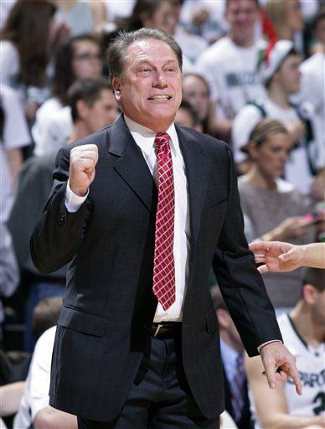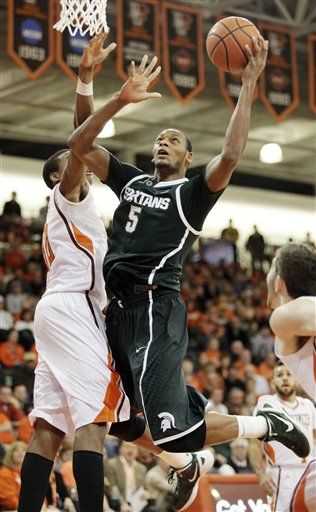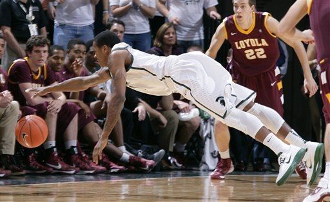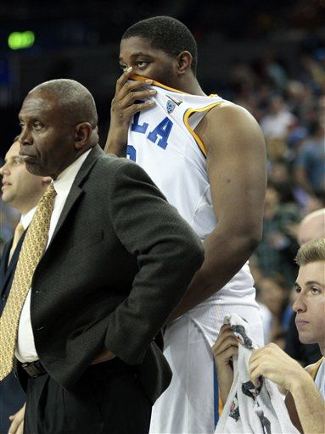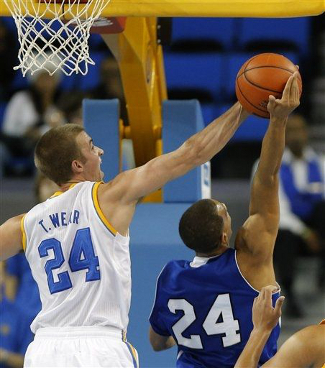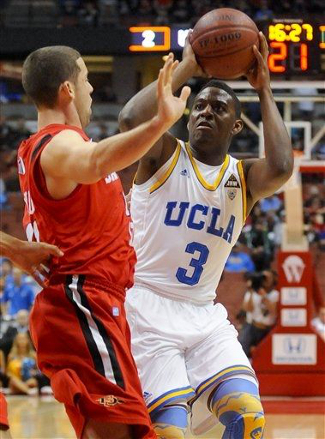#23/19 North Carolina Tar Heels (8-2) at Texas Longhorns (6-4)
Frank Erwin Center | Austin, TX | Tip: 8 P.M. CT | TV: ESPN2
LRT Consecutive Game #231
Last year, the one consistent storyline throughout the season was a lack of quality wins. The Longhorns spent the entire season on the bubble, with every win crucial to what would eventually become the program’s 14th-consecutive NCAA bid. Thanks to an inability to win close games, Texas finished the season with just three victories against the RPI Top 100, while its fans sweated the bubble until a Big 12 tournament win over Iowa State.
Although most fans have already written this season off as an abject failure, the truth is that we’re only about a third of the way through it. The absence of both Jaylen Bond and Myck Kabongo has been crippling, as evidenced in low offensive rebounding numbers and a sky-high turnover rate. The return of one or both of those players can only make the Longhorns better and increase the odds that they pull off some quality wins in league play.
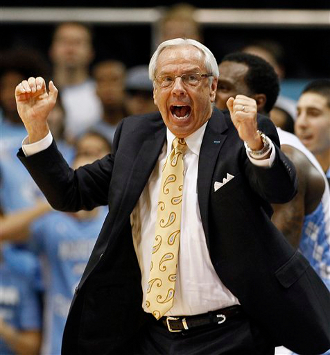
Roy Williams is fired up about his young team
(Photo credit: Gerry Broome/Associated Press)
Unfortunately, the Big 12 is under-performing to an alarming degree this season. Predicted to be a deep, difficult conference in 2012-13, the Big 12 now looks like Kansas, a couple of challengers, and a whole lot of muck. That gives the Longhorns six conference games against current RPI Top 50 teams and another six games against teams ranked between 51 and 100, with West Virginia just a few losses away from falling below that critical threshold.
Texas could certainly build a résumé on wins against OU, Baylor, and Iowa State, but it wouldn’t hold much weight when considered alongside a loss to D-II Chaminade. So, while no one would consider a mid-December game a “must win,” the importance of tonight’s game against UNC cannot be understated. The Tar Heels are young and inconsistent, and this match-up provides the opportunity for a quality win that can add some meat to the tournament résumé.
To pull off the upset without those two key Longhorns would not only impress the critics, but it would also give this inexperienced team some confidence heading into conference play. On the other hand, a loss does little to harm reputation. Many observers have already written the obituary on the 2012-13 Texas season, and another loss would likely go unnoticed. Tonight is a low-risk, high-reward situation for these young Longhorns, who have made some key improvements in the last two weeks. Now, fans will get to see what direction the team will be headed in for the next three months.
By the numbers
As usual, the Tar Heels love to get out and push the tempo, with their 75.4 possessions per game the third-fastest adjusted pace in Division I. While no one would confuse North Carolina with the pressure-loving teams of Mike Anderson, the Tar Heels can and do force mistakes, and they are always looking up court after rebounds and made buckets.
With John Henson and Tyler Zeller gone to the NBA, North Carolina is no longer an inside-out team that looks for paint touches every possession. Instead, this year’s Tar Heel squad loves to shoot it from outside. The team takes 28.7% of its shots from behind the arc, up from 23.5% a season ago. While North Carolina is not going to indiscriminately fire up three-pointers, this season definitely features a different approach to the half-court game.
As a result of the new look, North Carolina hardly ever gets to the free throw line. The Heels have a free-throw rate of just 22.6%, meaning they earn about one free throw for every five field goal attempts. That is the fifth-worst mark in all of D-I hoops, but it might actually be good for the sanity of North Carolina’s fans. The Heels have made less than 65% of their shots at the charity stripe, putting them in the bottom third nationally.
When looking at the big picture, the Heels are an imposing bunch on both ends of the court. North Carolina has an adjusted offensive efficiency of 1.08 points per possession, while allowing opponents an adjusted mark of just 0.891 points each time down the floor. Good interior defense and a solid job on the glass are both big components of that defensive dominance.
Meet the Tar Heels
With Kendall Marshall joining Henson and Zeller in this summer’s NBA Draft, the Heels have to rely on freshman Marcus Paige (No. 5) to run the show. The Iowa product is more of a scoring point, which is a marked difference from the pass-first approach that Marshall brought to the table. Paige is still adjusting to the college game, as evidenced by his early problems with turnovers. But after coughing it up four times in his collegiate debut and not logging a single assist, he’s steadily improved that ratio to a 1.36 assist-to-TO mark on the season.
Senior Dexter Strickland (No. 1) has spent much of his collegiate career as the backup point guard in Chapel Hill, and the arrival of Paige allowed him to move off the ball to the shooting guard spot. Still, he can’t completely leave that old role behind. With Paige more of a scoring guard, Strickland has actually taken over the team lead in assists. He’s averaging five per game, and that resurgence as a floor general gives Coach Roy Williams incredible flexibility in the backcourt with a pair of guards that can both run the point and also score in bunches.
Strickland is much better as a slashing, driving guard, but he’s clearly been working on the jump shot. Although he’s only made 26.7% from behind the arc this season, Dexter is still taking the triples and long-range twos a few times each game. That persistence seems to finally be paying off, as his accuracy on mid and long-range jumpers has improved over the last few games.
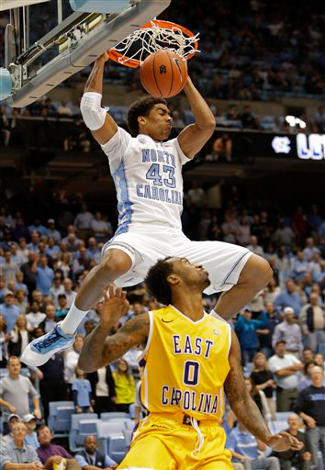
James Michael McAdoo is the BMOC in Chapel Hill
(Photo credit: Gerry Broome/Associated Press)
The third guard for the Tar Heels is 6’7″ sharpshooter Reggie Bullock (No. 35). That height makes it tough for opposing guards and wings to prevent him from launching three-pointers, and he’s more than happy to take advantage. More than 55% of his shots have come from behind the arc this season, and Bullock has knocked down 46.9% of those attempts. He’s not a guy who is going to put the ball on the floor and get to the rack, so opponents have to stay in his shirt and communicate when he’s run off of screens.
Although Bullock is an incredibly dangerous offensive weapon, the team’s new star is sophomore James Michael McAdoo (No. 43). A relative of the great Bob McAdoo, this soft-spoken big man is a handful for opposing defenses. McAdoo has a good post repertoire, a great midrange game, and is a confident, aggressive driver. He also has a quick release and makes swift post moves, so defenses are often caught off-guard when he suddenly pops an uncontested look. McAdoo is tops on the team with 15.4 points per game and 8.3 boards.
The fifth starting spot has belonged to a rotating cast of characters, but it was most occupied by freshman Brice Johnson (No. 11). At 6’9″, the freshman from South Carolina is still very thin and wiry compared to most opposing post players. Still, he has a knack for finding the ball near the rim, and he makes great cuts without the ball to get himself in scoring position. His great hops and athleticism also make him tough on the boards, and he’s already provided some rim-rattling dunks this season. With some more experience and a few more pounds of muscle, Johnson is going to be a very exciting player for the Heels.
The other post option is fellow freshman Joel James (No. 0), a 6’10” big man with a soft touch and a lot of raw talent. He didn’t begin playing organized basketball until his sophomore year of high school, so there’s still a lot of learning on the fly for James. He lets himself get pushed out of position on the blocks and on the boards, so he will have to improve his court awareness and his assertiveness to make a bigger impact for UNC. Self-improvement has been no problem for James, however, a fact he proved by losing more than 50 pounds in one summer. If he applies that mental focus to improving his post game, this skilled big is going to be a beast in the ACC.
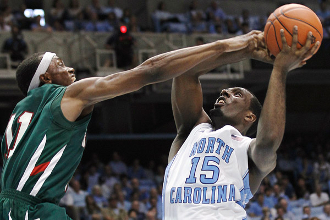
P.J. Hairston is a difference-maker off the bench
(Photo credit: Gerry Broome/Associated Press)
Off the bench, P.J. Hairston (No. 15) is a strong, aggressive guard who can put the ball on the floor and get to the rim. At 6’5″ and 220 pounds, he’s a handful for most defenders, and he has the strength to fight through contact. When he’s being confident and decisive, Hairston can take over a game. When he’s not providing that spark for the offense, it clearly shows for North Carolina. He did not make the trip to Indiana after spraining his knee in practice, and the offense sorely missed his ability to create as they were blown out by the Hoosiers.
Leslie McDonald (No. 2) is a junior who also brings a scoring punch off the bench. His 10 points per game is fourth on the team, despite the fact he’s started only one game. McDonald shoots threes even more often than Bullock, having taken nearly 57% of his shots from long range this year. Bullock does top him in one category, though, as McDonald’s 46.7% accuracy is just a bit shy of the team lead.
The final member of the core rotation is freshman J.P. Tokoto (No. 25), a solid defender with a lot of length. Tokoto has an impressive wingspan that he uses to disrupt passing lanes and challenge shots, and his lateral quickness on the perimeter makes it tough to beat him. Like fellow freshman Johnson, Tokoto has athleticism in spades and possesses the ability to jump right out of the gym.
Desmond Hubert (No. 14) and Luke Davis (No. 4) will also likely see limited action in this one. Hubert was the fifth starter for many of the early-season games, but his ineffectiveness in the post has limited him to a reserve role. Davis provides a few minutes per game at the point, and is playing as a walk-on after transferring following his freshman season at Gardner-Webb.
Keys to the game
1) Stop the ball in transition – North Carolina is practically unstoppable when they are piling up the points in transition, as the sophomore class of Longhorns can remember well from their visit to Chapel Hill last season. The Tar Heels are still inconsistent in the half-court set, a fact made glaringly clear in their losses to Butler and Indiana. If Texas can prevent the Tar Heels from getting easy buckets in transition and force them to work for their points in the half court, that already-tough Longhorn D can really stifle the UNC attack.
2) Push McAdoo out of his comfort zone – One player who is especially dangerous even in those half-court sets is the future NBA star McAdoo. If he gets the ball in a post-up situation, he doesn’t even need time to feel up the defender and then make a move. He can quickly spin and pop a jumper, or go right to the effective baby hook. Where he’s most deadly, though, is catching the ball as he’s already moving towards the hoop. With his long legs and one power dribble, he can get to the rim in an instant and finish for two.
For Texas, this means that McAdoo has to be forced off of the blocks and has to receive passes with his back to the hoop or his momentum moving away from the rim. There’s no way Texas can do this on every possession, but if they can force McAdoo into the spots they want him for much of the game, it will certainly limit his effectiveness.
3) Silence the three-point shooters – Shutting down McAdoo won’t make much of a difference if Bullock or McDonald get hot from long range. Both players have proven they can score in a hurry, as McDonald dropped six triples on Mississippi State and another five on UAB, while Bullock has made at least three of them in five different games. Although it can be very hard to prevent the lanky Bullock from getting his shot off, the Longhorns need to chase him off the perimeter and they need to challenge McDonald’s looks.
4) Clean up the defensive glass – Even if Texas can do all of these things on defense, it still will be a futile effort if they don’t close out possessions with defensive rebounds. Fortunately, the Heels have had some major struggles on the offensive glass against quality competition, so the chances are good for the Longhorns.
In UNC’s win over East Carolina on Saturday, not a single Tar Heel post player reclaimed one of his team’s missed shots. It was the third time Carolina was held to an offensive rebounding mark of less than 30%, with the other two coming in losses to Butler and Indiana.
Texas has done an average job so far this season on the defensive glass, but the team is coming off two strong rebounding performances against UCLA and Texas State. The Longhorns held both teams to offensive rebounding marks under 27%, which is impressive when you consider the length on that Bruin squad with the likes of Kyle Anderson and the Wear twins. If the Horns can continue that recent trend tonight, they can keep themselves in this ballgame until the end.
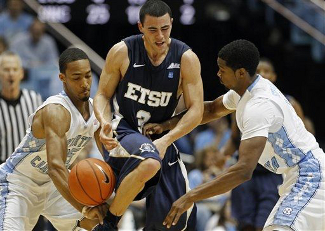
UNC’s defense could give Texas some problems
(Photo credit: Gerry Broome/Associated Press)
5) Hang on to the ball – As promised, the perennial Key to the Game returns for the North Carolina match-up. While the Heels aren’t a team that is pressuring 100% of the time, they do key in on weaknesses that present opportunities to trap and press. Against a Longhorn team that has frequently turned it over, you can be sure that Coach Williams will throw in a few extra pressure situations to force mistakes and fuel that transition game.
The Longhorns have done a much better job at controlling the basketball in their last two games against UCLA and Texas State, but it will be challenging to do the same against North Carolina tonight. The last time they faced a team with this much length and athleticism, the Longhorns turned it over on 32% of their possessions against Georgetown. If they can avoid that kind of meltdown tonight, the Horns will at least have a chance to pull off an impressive upset.
| 







